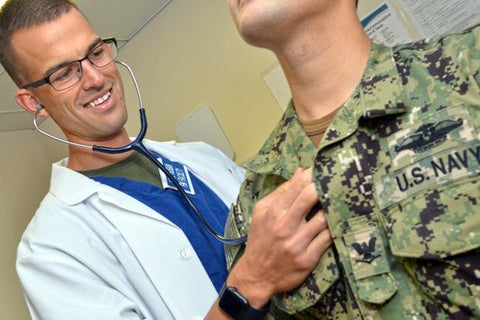All branches of the military, with the exception of the U.S. Marine Corps and U.S. Space Force, have military doctor billets. Being a military doctor can be rewarding because a military doctor doesn’t just serve the country, he or she also serves their patients. And in some cases, like flight surgeons, they can also be aviators on flight status (not necessarily pilots), a nice perk for those who can get the rating.
There are multiple paths to becoming a military doctor, but we will focus this post on the two more popular methods of becoming a military doctor.
To become a military doctor in the U.S. armed forces, there are two primary avenues: the Uniformed Services University of the Health Sciences (USUHS) or the Health Professions Scholarship Program (HPSP).

USUHS
The USUHS, in Bethesda, Maryland, is sometimes referred to as America’s Medical School. It opened its doors in 1972 as a way to create more military doctors. Applicants accepted to the USUHS are placed on active-duty and their education is paid for by the U.S. government. Think of it as a service academy for the military doctor. Applicants can serve as commissioned officers in the Army, Navy, Air Force, and U.S. Public Health Service as a military doctor. Attendees of USUHS, though not military doctors, are considered military officers and must wear their uniforms to class and they are on active duty for the duration of medical school.
Prior to starting at USUHS, candidates are required to attend an officer orientation program to help them transition into military service. Once completed, they can begin their military doctor training. It’s important to note that once a student enters USUHS, they are commissioned as second lieutenants or ensigns, depending on branch choice. They earn O-1 pay while in school for the duration. They are also entitled to full military benefits like medical care, housing allowance and 30 days paid vacation.
Graduates of USUHS are required to serve a seven-year active-duty service commitment as a military doctor. They are then promoted to the rank of captain or the grade of O-3 upon attaining status as a military doctor. Applicants choosing to serve in the U.S. Public Health Service assume a ten-year active-duty obligation.
HPSP
The branches have their scholarship programs located at HPSP Air Force, HPSP Navy and HPSP Army online. All of these are great ways to become a military doctor, but it is important to note that the HPSP is a scholarship program that enables candidates to attend the medical school of their choice. A candidate’s medical school tuition is paid for by the U.S. government and they receive a monthly stipend as they train to be a military doctor.

In HPSP, the military service portion is different as candidates are commissioned as an officer in the IRR (Individual Ready Reserve) as opposed to USUHS where a candidate starts serving and wearing a uniform when they report to the school. In both cases, it leads to a person becoming a military doctor.
As an HPSP participant, your medical training is similar to civilians. Candidates attend medical schools of their choice on their way to becoming a military doctor and there are no military uniforms worn. However, scholars are required to attend officer training and one 45-day training session for each year they receive scholarship funds. Uniforms are required during training periods. Similar to USUHS, candidates must attend an officer orientation in their first two years. During the periods of officer orientation training and the 45-day training sessions, students are paid as O-1s.
Upon completion of their medical school training, candidates are given a $20,000 signing bonus for joining the Army, Navy or Air Force and they incur a one-year service obligation for every year they received scholarship funds. So, four years of medical school would require for years of service as a military doctor. Once you enter active duty, you become a captain or an O-3 in grade.
Leave a comment
Please note: comments must be approved before they are published.